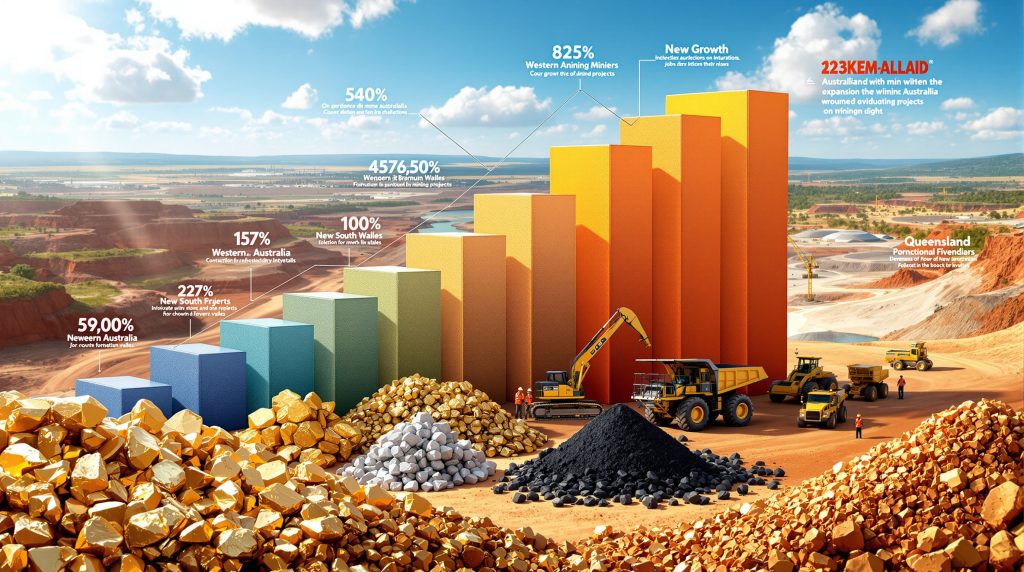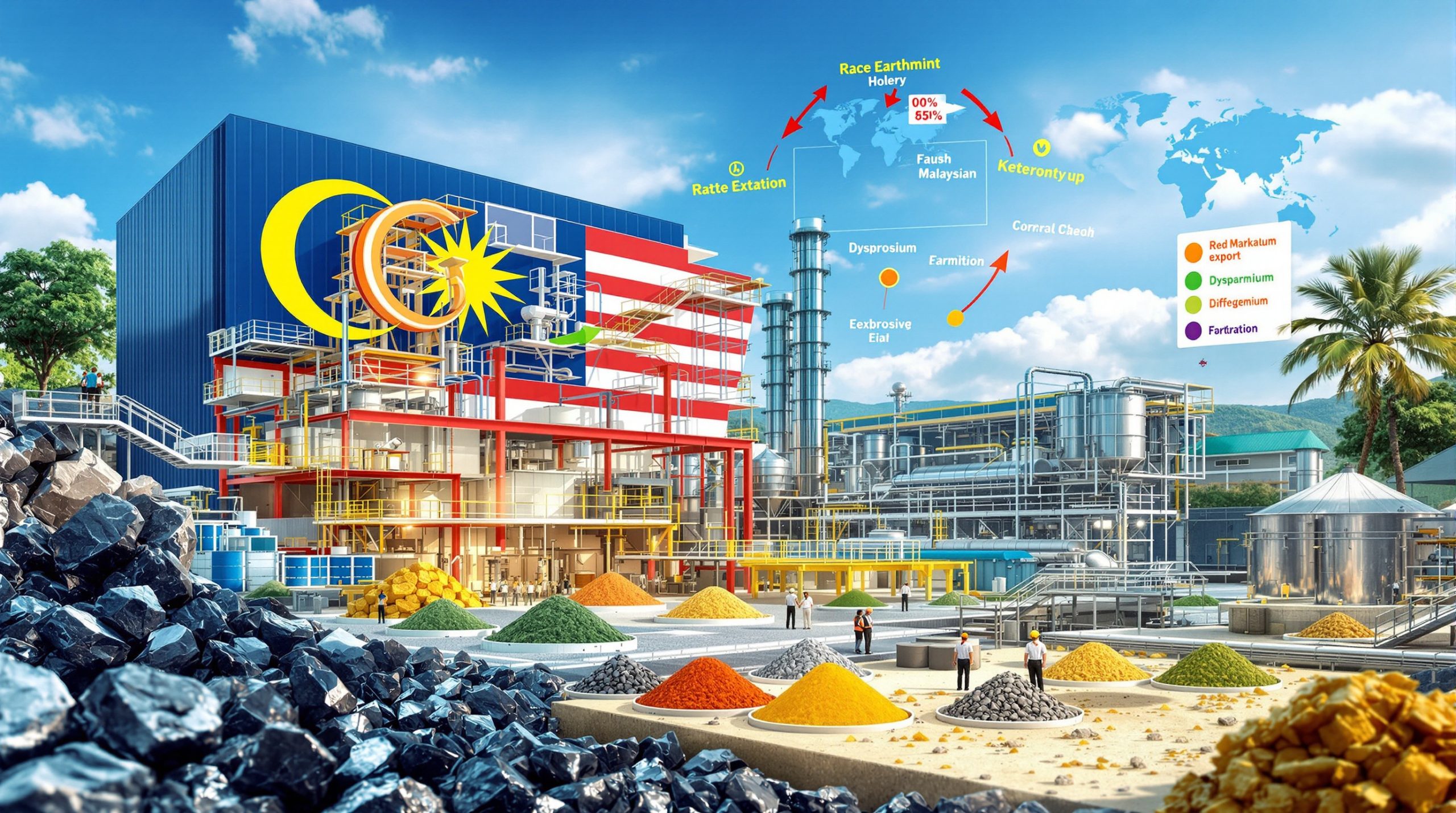Australian Mining Industry Growth Forecast 2025-2030: Rebounding Toward Expansion
After navigating turbulence in 2024, the Australian mining industry is staging a remarkable comeback with projections indicating steady growth through 2030. This resurgence demonstrates the sector's inherent resilience and adaptability, with new projects, workforce expansion, and commodity diversification setting the stage for a sustainable recovery in this vital economic pillar.
What Is Driving the Current Mining Industry Recovery?
The Australian mining industry is experiencing a significant rebound after facing challenges in 2024, with projections showing a return to growth over the next five years. According to the latest Australian Resources and Energy Employer Association (AREEA) workforce forecast, the sector is positioned for moderate but steady expansion through 2030.
The industry's resilience is evident in its ability to recover from recent difficulties, with direct employment already rebounding to near-record levels following the turbulence experienced in 2024. This recovery marks a decisive turning point that establishes a clear growth trajectory for the coming years.
Several factors are powering this resurgence, including robust global demand for critical minerals for energy transition, continuing strength in traditional commodities like iron ore, and renewed investment confidence in Australia's mining capabilities despite intensifying global competition.
Industry experts note that while the pace of growth may be more measured than during previous boom cycles, the recovery demonstrates the sector's fundamental strength and importance to Australia's economic outlook. The mining industry continues to serve as a cornerstone of national prosperity, contributing substantially to export earnings, tax revenue, and employment opportunities.
How Many New Mining Projects Are Expected by 2030?
Project Pipeline Overview
The mining landscape is set to welcome 96 major projects between late 2025 and 2030, with a combined valuation of $129.5 billion. These developments are expected to create substantial employment opportunities and strengthen Australia's position in the global resources market.
| Sector | Number of Projects | New Jobs Created |
|---|---|---|
| Mining | 80 | 19,425 |
| Energy | 16 | 2,854 |
| Total | 96 | 22,279 |
This projected workforce expansion represents a 7.1% increase in the national resources and energy workforce by 2030, though the AREEA report notes this is the lowest five-year outlook in more than half a decade.
Unlike previous cycles, a larger-than-usual proportion of job creation (approximately 7,500 positions) is expected to materialize in the latter half of the forecast period (2028-2030). This extended recruitment timeline suggests a more measured approach to project development and highlights the complex planning horizons now typical in the resources sector.
Industry analysts attribute this extended timeline to several factors, including more rigorous environmental approval processes, detailed feasibility studies, and strategic phasing of capital expenditure to optimize returns on investment. This cautious approach reflects lessons learned from previous boom-bust cycles and demonstrates a maturation in modern mine planning processes.
Which Mining Roles Will See the Highest Demand?
The workforce requirements across these projects reveal specific skill demands that will shape recruitment strategies in the coming years:
- Plant operations: 8,110 positions (36% of total demand)
- Heavy diesel fitting: 2,700 positions (12% of total demand)
- Other trades (electrical and maintenance): 845 positions (4% of total demand)
- Supervision, management, and administration: 3,885 positions (17% of total demand)
- Mine engineering, technical, and geology services: 3,885 positions (17% of total demand)
This distribution highlights the diverse range of skills required in modern mining operations, with strong demand across both operational and technical roles. The significant need for plant operations personnel underscores the industry's continued reliance on skilled operational workers despite increasing automation.
The substantial requirements for supervision and technical roles (collectively 34% of projected positions) also reflects the growing complexity of mining operations and the premium placed on specialized knowledge in areas such as mine engineering, geology, and environmental management.
Industry education providers are already responding to these projected needs by developing specialized training programs targeted at high-demand roles, particularly in regional areas where skills shortages have historically been most acute. However, concerns remain about whether traditional training pathways can deliver sufficient qualified personnel within the required timeframes, potentially creating competition for skilled workers among concurrent projects.
How Does Growth Vary Across Australian States?
State-by-State Project Distribution
The distribution of mining projects and associated employment opportunities varies significantly across Australian states, reflecting shifting investment priorities and regulatory environments:
| State | Current Projects | Current Jobs | Previous Projects | Previous Jobs | Trend |
|---|---|---|---|---|---|
| Western Australia | 42 | 8,924 | 48 | 11,065 | ↓ |
| Queensland | 17 | 4,412 | 11 | 3,527 | ↑ |
| New South Wales | 11 | 3,290 | 19 | 5,412 | ↓ |
Queensland has emerged as a bright spot with increasing project numbers, with the AREEA report noting the state has "firmly re-established itself as the nation's second most attractive mining destination." This resurgence represents a 54.5% increase in projects and a 25.1% growth in associated jobs compared to previous forecasts.
However, industry observers caution that Queensland's growth trajectory faces potential headwinds from the state's coal royalty regime. The AREEA report specifically warns that "there remains a risk any new workforce demand could be offset by significant coal sector job losses" due to this policy framework.
Western Australia, while experiencing a moderate decline in project numbers, maintains its position as Australia's mining powerhouse with 42 projects representing 44% of the national total. The state's continued dominance reflects its world-class mineral deposits, established infrastructure, and supportive regulatory environment.
New South Wales has experienced the steepest decline, with project numbers falling by 42.1% and associated job projections dropping by 39.2%. Industry stakeholders attribute this trend to a combination of regulatory challenges, permitting complexities, and land use conflicts that have created uncertainty for potential investors.
Which Commodities Will Drive Future Mining Growth?
Commodity Diversification Trends
While traditional resources remain important, Australia's mining project pipeline is increasingly diversifying:
- Emerging commodities: 21 projects in alumina, graphite, phosphate, and mineral sands (requiring approximately 3,000 workers)
- Gold, copper, and critical minerals: Strong projected contributions to workforce demand
- Traditional powerhouses: Iron ore (8 projects / 3,400 workers) and coal (7 projects / 3,100 workers) continue as reliable economic drivers
This diversification reflects global demand shifts toward materials essential for renewable energy technologies and advanced manufacturing, while maintaining strength in traditional export commodities. The increasing prominence of critical minerals aligns with national strategic priorities around supply chain security for technologies crucial to the energy transition.
The significant number of projects in emerging commodities demonstrates Australia's evolving response to changing global demand patterns. Materials such as graphite (essential for battery anodes) and rare earth elements (crucial for permanent magnets in electric vehicles and wind turbines) represent growth areas that leverage Australia's diverse mineral endowment beyond traditional bulk commodities.
Iron ore and coal projects, while fewer in number than during previous cycles, continue to represent substantial employment opportunities due to their scale and operational requirements. These established sectors benefit from well-developed infrastructure, existing workforce capabilities, and established export relationships that reduce development risks.
What Challenges Could Impact the Mining Industry's Growth Trajectory?
Despite the positive outlook, several factors could influence the industry evolution trends and growth potential:
- Regulatory complexity: Increasing red tape and approval processes may delay project timelines
- Global competition: Intensifying international competition for mining investment capital
- State-specific policies: Queensland's coal royalty regime potentially offsetting job creation
- Workforce availability: Potential skills shortages as multiple projects compete for specialized talent
- Capital cost inflation: Rising construction and development costs affecting project economics
- Social license concerns: Growing community expectations regarding environmental and social impacts
Industry leaders consistently identify regulatory complexity as a significant concern. The AREEA report highlights "mounting red tape" as a key challenge that extends project development timelines, increases costs, and creates uncertainty for investors considering Australian opportunities against global alternatives.
Global competition for mining investment has intensified as many nations seek to develop their resources sectors, particularly in critical minerals. Countries with streamlined approval processes, favorable tax regimes, or strategic industry support may capture investment that might otherwise flow to Australian projects.
Workforce availability represents a practical constraint on development timelines, with concurrent project schedules potentially creating competition for skilled personnel. This challenge is particularly acute in specialized technical roles where qualification pathways require years of training and experience.
"Iron ore, coal and gas remain the bedrock of our export earnings, taxes and royalties. Without this sector, there would be no federal surpluses and no reliable funding for hospitals, schools, Medicare or aged care," noted AREEA chief executive Steve Knott AM, highlighting the sector's continued importance to the national economy.
How Does This Forecast Compare to Previous Years?
The current projection represents a moderate slowdown compared to recent years but marks an important turnaround from the challenges experienced in 2024. The reset toward growth, even at a more measured pace, demonstrates the mining industry's resilience and adaptation to changing market conditions.
The AREEA report characterizes the forecast as "a moderate slowdown in the project and workforce pipeline compared with recent years." However, this moderation should be viewed in context – the previous five years included exceptionally strong investment growth that would be difficult to sustain indefinitely.
Industry analysts note that the current forecast represents a healthier, more sustainable growth trajectory that may avoid some of the inflationary pressures and skill shortages that characterized previous boom periods. This measured expansion could potentially deliver more stable, long-term benefits to mining communities and the broader Australian economy.
The reduction in overall project numbers compared to previous outlooks also reflects increased selectivity from investors, with capital flowing to the most economically robust opportunities. This trend suggests a maturation of the investment approach that prioritizes quality over quantity – a positive signal for the sector's long-term sustainability.
What Does This Mean for Mining Industry Employment?
The forecast of 22,279 new operational jobs by 2030 represents significant opportunities across the mining value chain. The distribution of these positions across both traditional roles (such as plant operations) and specialized technical areas reflects the industry's evolving needs as it embraces new technologies and operational approaches.
This projected 7.1% increase in the national resources and energy workforce will create particular demand for skilled trades, with heavy diesel fitting (2,700 positions) standing out as a critical area of need. The substantial requirements for supervision, management and technical roles (collectively 7,770 positions) also highlights the growing complexity of mining operations.
Educational institutions and training providers face the challenge of aligning their programs with these projected workforce needs. Industry partnerships with vocational education providers will be essential to developing targeted training initiatives that can deliver qualified personnel within the required timeframes.
For individual workers, these projections signal continued strong employment prospects in the resources sector, with opportunities spanning operational, technical, and managerial roles. The geographic distribution of projects also suggests that regional mining communities will continue to benefit from employment growth, though the specific impacts will vary by location.
How Will Regional Mining Communities Be Affected?
The geographic distribution of projects will have varying impacts on regional mining communities:
- Western Australia: Despite the reduction in project numbers, remains the dominant mining state with 44% of all projects
- Queensland: Potential for renewed growth, particularly in regions with diverse mineral deposits
- New South Wales: Facing a more challenging outlook with reduced project numbers
These regional variations will influence local economic development, infrastructure requirements, and community planning in mining-dependent areas. Western Australia's continued strength provides a stable foundation for regional economies, while Queensland's resurgence offers growth potential for communities that have experienced fluctuating fortunes in recent years.
The diversification of commodities may also create opportunities for regions with deposits of critical minerals or other emerging resources. Communities that have historically relied on single commodities may benefit from this broadening focus, potentially reducing their vulnerability to commodity price cycles.
Local governments in mining regions will need to consider these projections in their infrastructure and service planning. The substantial workforce requirements, particularly in the first three years of the forecast period, may create pressure on housing markets, educational facilities, and community services in areas experiencing significant project development.
Conclusion: Balanced Growth Outlook for Australian Mining
The Australian mining industry appears well-positioned for measured growth through 2030, with diverse commodity development offsetting challenges in traditional sectors. While the pace may be slower than previous boom periods, the forecast suggests a sustainable expansion that balances economic opportunity with industry evolution.
The combination of traditional resource strength and emerging commodity development provides a foundation for continued industry resilience, though regulatory challenges and global competition will require ongoing adaptation and innovation from industry participants.
The projected creation of 22,279 new jobs by 2030 highlights the sector's continued importance as an employment generator, with opportunities spanning operational, technical, and managerial roles. This workforce expansion will create both opportunities and challenges for mining regions, educational institutions, and industry stakeholders.
As the industry navigates this growth trajectory, continued dialogue between government, industry, and communities will be essential to addressing challenges while maximizing the benefits of resource development for the Australian economy and society. The continued exploration for gold and copper alongside other minerals will remain crucial for maintaining Australia's competitive position in global markets, while investors should monitor share market performance insights to gauge the sector's financial health.
Disclaimer: This article contains forecasts and projections that are subject to various uncertainties and external factors. Actual outcomes may differ materially from those discussed. Readers should consider multiple information sources and perspectives when making decisions based on industry outlooks and mining risk forecasts.
Want to Capitalise on the Next Major Mining Discovery?
Discovery Alert's proprietary Discovery IQ model delivers real-time notifications on significant ASX mineral discoveries, providing investors with actionable insights ahead of the market. Learn more about how historic discoveries have generated substantial returns by visiting the dedicated discoveries page and position yourself for the next major opportunity.




